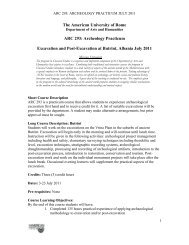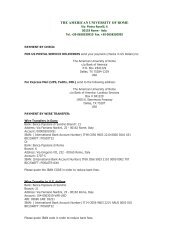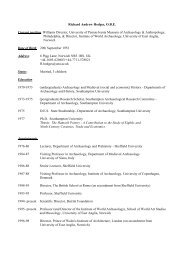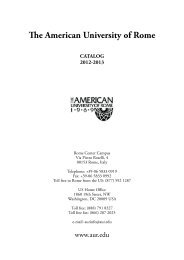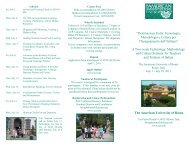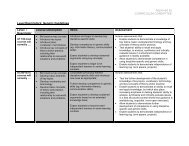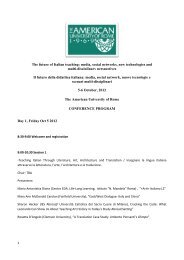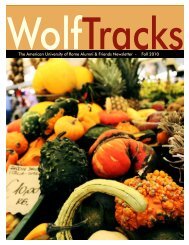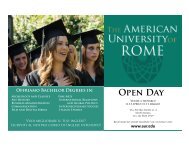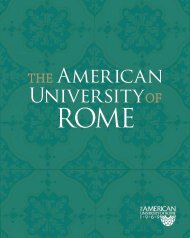Women and Comedy: History, Theory, Practice - The American ...
Women and Comedy: History, Theory, Practice - The American ...
Women and Comedy: History, Theory, Practice - The American ...
You also want an ePaper? Increase the reach of your titles
YUMPU automatically turns print PDFs into web optimized ePapers that Google loves.
<strong>Women</strong> <strong>and</strong> <strong>Comedy</strong>: <strong>History</strong>, <strong><strong>The</strong>ory</strong>, <strong>Practice</strong> 1THE WORKSHOPIn most theories of comedy, from classic treatises by Sigmund Freud <strong>and</strong> Henri Bergson torecent polemics by Christopher Hitchens, women are figured as neither agents nor audiences ofcomedy, merely its targets. Only relatively recently have scholarly study <strong>and</strong> popular culturealike begun to recognize <strong>and</strong> historicize women’s active contributions to comedy.<strong>Women</strong> <strong>and</strong> <strong>Comedy</strong>: <strong>History</strong>, <strong><strong>The</strong>ory</strong>, <strong>Practice</strong> brings together leading researchers fromCanada, the United States, <strong>and</strong> Europe in an interdisciplinary workshop format to highlight thebreadth of current scholarship on gender <strong>and</strong> comedy. This scholarship spans centuries of literary<strong>and</strong> cultural production, a diversity of critical methodologies, <strong>and</strong> a range of popular <strong>and</strong> politicalapplications.<strong>The</strong> workshop has three primary objectives: to advance research in humor, gender,performance, film, rhetoric, communication, <strong>and</strong> literary criticism by way of participants’ sharedinterest in the topic of women <strong>and</strong> comedy; to develop out of the workshop presentations acollection of essays that will bring into productive dialogue the interdisciplinarity whichcharacterizes research on this subject; <strong>and</strong> to engage undergraduate <strong>and</strong> graduate studentsenrolled in cognate courses taught by members of the organizing committee in h<strong>and</strong>s-onexperiential learning on the subject. In so doing, the workshop will address the followingresearch issues:1. It will respond to the historical marginalization <strong>and</strong>/or trivialization of both women <strong>and</strong>comedy. Through a reconsideration of literary <strong>and</strong> cultural texts from the Classical periodto the present, the workshop will assert the importance of recognizing the role of women<strong>and</strong> comedy in order to underst<strong>and</strong> these texts <strong>and</strong> their historical contexts.2. It will analyze the topic of women <strong>and</strong> comedy through a diversity of theoretical <strong>and</strong>methodological approaches. Given comedy’s unpredictable <strong>and</strong> irreverent character,these acts of analysis will allow for opportunities to reevaluate the theoretical approachesthemselves.3. It will ground these theoretical analyses in the actual practice of comedy, <strong>and</strong> in theexperiences of audiences encountering different genres of comedic texts <strong>and</strong>performances. Acknowledging the performer’s role in this encounter, the workshop willconclude with a roundtable in which performers from different disciplines will shareaspects of their craft with the attending scholars. In this way, the workshop seeks tobridge research, performance, <strong>and</strong> reception.Generous financial support for this workshop has been provided by: the Social Sciences <strong>and</strong>Humanities Research Council of Canada; the Department of English, SFU; the Faculty of Arts<strong>and</strong> Social Sciences, SFU; <strong>and</strong> the Office of the Vice-President, Academic, SFU.Members of the workshop organizing committee include: Sarah Creel; Peter Dickinson; AlanaGerecke; Anne Higgins; Paul Matthew St. Pierre; Diana Solomon; <strong>and</strong> Sean Zwagerman.
<strong>Women</strong> <strong>and</strong> <strong>Comedy</strong>: <strong>History</strong>, <strong><strong>The</strong>ory</strong>, <strong>Practice</strong> 3repeat this curious comedy, in representations of Joseph asleep at crucial moments, oridly drilling holes in his shop while Mary meets Gabriel in the central panel. If Joseph isalways a comic cuckold, then who is Mary? And how is she like the ordinary women ofthe late medieval audience?2. Lisa Perfetti, Whitman College: “Feminist Humor without <strong>Women</strong>: <strong>The</strong> Challenge ofReading (in) the Middle Ages”In my paper, I will draw from Chaucer’s Canterbury Tales <strong>and</strong> Boccaccio’s Decameron.Both authors pose the question “What would happen if women had the same access topublic discourse that men have? While in some sense their comic texts suggest that suchaccess is laughable, gender itself is also the butt of the humor. Focusing on momentswhere female protagonists specifically invoke gender categories before a public audience(“you men” <strong>and</strong> “we women”), I will consider how the female characters can be seen tobe highlighting the performative dimensions of gender. I will furthermore connect this tothe way in which both Boccaccio <strong>and</strong> Chaucer address the ethical dimensions of reading,to which I allude in the second part of my title, meant to suggest both the challenge for usof knowing what humor was like for women in the Middle Ages, but also questions thetexts themselves engage about authorial responsibility <strong>and</strong> readers’ roles in relation togender.12:45-1:45 pm Lunch1:45-3:15 pm Panel 3: <strong>Women</strong> Actors, <strong>Women</strong>’s Relations: New Approaches to EarlyModern <strong>Comedy</strong>1. Pamela Brown, University of Connecticut: “Have Wit Will Travel: Female Trickstersin the Italian Commedia dell'arte <strong>and</strong> English <strong>Comedy</strong>”Comedies with female tricksters appeared in Italy soon after women began to play incommedia dell'arte troupes in the mid-16c. <strong>The</strong> novella-derived comic trick, or beffa,showcased the actress's extemporal wit, timing, <strong>and</strong> skill at mimicry <strong>and</strong> disguise. InEngl<strong>and</strong>, news of the female comici spread quickly, especially in the 1570s, when Italianplayers were brought to Elizabeth's court, stepping up interest in the Italian companiesjust as the new commercial theater was established. Rather than open their stages toactresses, playwrights from Lyly to Fletcher adapted the models made famous by theforeign stars. Shakespearean examples include Bianca of Taming of the Shrew, Rosalindof As You Like It, Maria of Twelfth Night <strong>and</strong> Portia of Merchant of Venice. My paperwill trace the early metamorphoses of the female trickster as the type traveled from pageto stage, from female to male bodies, <strong>and</strong> from Continental stages <strong>and</strong> audiences toEnglish ones.2. Julie Crawford, Columbia University: “Female Friendship, Marriage, <strong>and</strong> the Structuresof Shakespearean <strong>Comedy</strong>”
<strong>Women</strong> <strong>and</strong> <strong>Comedy</strong>: <strong>History</strong>, <strong><strong>The</strong>ory</strong>, <strong>Practice</strong> 4It is a commonplace of Shakespeare criticism that the comedies end in marriage. It is alsosomething of a commonplace that marriage signals the end of women’s relationships,erotic or otherwise. Yet the formal claims that we make about Shakespearean comedies,most notably that they plot a heterosexual love story <strong>and</strong> they end in marriage, areintimately caught up with the formal <strong>and</strong> teleological expectations – the storylines – wehave about human sexuality <strong>and</strong> its workings. While same-sex bonds may punctuate, oreven help to structure, the story of a life, or a play, most critics insist, they are ultimatelysucceeded by marriage. In contrast, this essay seeks to reexamine what we think comedydoes by reexamining the relationships between women that so often serve as one of itskey structural principles. <strong>The</strong> women’s bonds that structure comedies like All’s Well ThatEnds Well, As You Like It, Twelfth Night, <strong>and</strong>, with some generic variation, <strong>The</strong> Merchantof Venice, are in many ways secured through rather than ended by marriage, <strong>and</strong> thestructures they facilitate, both generic <strong>and</strong> social, are much more complicated than wethink.3:15-3:45 pm Break3:45-5:15 pm Panel 4: <strong>The</strong> Transatlantic Contexts of 18 th - <strong>and</strong> 19 th -Century <strong>Women</strong>’sHumor1. Linda Morris, UC Davis: “Domestic Manners of the <strong>American</strong>s: A TransatlanticEndeavor”When the Englishwoman Frances Trollope published <strong>The</strong> Domestic Manners of the<strong>American</strong>s in 1832, she outraged readers in the new republic, who nevertheless boughther book in record numbers. <strong>Women</strong>, especially, were the objects of her stingingcriticism. But if readers thought they could dismiss her satiric barbs as the work of anuninformed casual visitor to the US, they had no such excuse when native-born womenhumorists took on the domestic manners of their neighbors. Caroline Kirkl<strong>and</strong>, in A NewHome—Who Will Follow?, <strong>and</strong> Frances M. Whitcher, in <strong>The</strong> Widow Bedott Sketches,both held their female neighbors up to ridicule in the two decades following thepublication of Domestic Manners. How did their criticisms differ from Trollope’s? Howdid their art differ? Should Trollope be considered the mother of <strong>American</strong> domestichumor, a str<strong>and</strong> of humor that extends down to our own day? <strong>The</strong>se will be the questionsaddressed in this presentation.2. Diana Solomon, Simon Fraser University: “<strong>The</strong> Amazon <strong>and</strong> the Weakling: ComicFigures in Margaret Cavendish’s closet dramas”<strong>The</strong> mid-17th Century English writer Margaret Cavendish wrote prolifically, but facedgender <strong>and</strong> class-based resistance to going public with her work. Her texts contain severalelements that read as attempts both to resolve the anxiety of publishing <strong>and</strong> createsympathetic readers. I want to argue that Cavendish established her authority <strong>and</strong>negotiated the process of publishing her dramatic writing in part by creating two comicfigures that appear in the prologues <strong>and</strong> epilogues of several of her plays. <strong>The</strong> first ofthese figures, the Amazon, wields the pen as a weapon <strong>and</strong> acts indifferent to her critical
<strong>Women</strong> <strong>and</strong> <strong>Comedy</strong>: <strong>History</strong>, <strong><strong>The</strong>ory</strong>, <strong>Practice</strong> 5reception, while the second character, the weakling (both are my terms), is anemasculated male figure who fears the Amazon’s wrath. Through the charades of thesetwo characters, Cavendish courts audience approval in a metadrama that runs throughouther two volumes of plays. Cavendish is thus one of a number of early modern womenwriters for whom the ongoing project of recovery work needs to involve reading forcomedy as both an end in itself <strong>and</strong> as a strategic negotiation of the public.5:30-8 pm Reception <strong>and</strong> Performance by Margaret Leng Tan—Segal Centre (HC 1400)Day 2, Friday, August 5 th : Approaches, Texts, <strong>and</strong> Audiences—Terasen Cinema9-9:30 am Coffee <strong>and</strong> muffins9:30-11 am Panel 1: <strong>The</strong> Rhetoric of <strong>Women</strong>’s Political Humor1. Tarez Graban, Indiana University: “Humoring the Female Pol: Irony, Consciousness-Raising, <strong>and</strong> ‘Third-Culture’ Discourse”“Humoring the Female Pol” is a methodological project <strong>and</strong> the first step in a broadexamination of contemporary feminist diplomatic discourse. On the one h<strong>and</strong>, I articulatethe theoretical consciousness-raising that is made possible by considering ways ofmarking irony in the diplomatic discourse of contemporary political women. On the otherh<strong>and</strong>, I consider – in a corpus this broad – what can <strong>and</strong> should be the nature of thatmarking, especially when examining irony as a mode of civil engagement in transnationalor cross-cultural conflicts? While this paper focuses on selected texts by MadeleineAlbright, my target study extends from Golda Meier (1898-1978) to Ellen JohnsonSirleaf (b. 1938), <strong>and</strong> considers both humorous <strong>and</strong> non-humorous irony across thegenres that these writers tend to produce. Ultimately, I argue for irony’s place in theformulation <strong>and</strong> maintenance of what might be called their “third-culture” identities. Imake the base claim that their ironic discourse is rhetorical, of course, but that its greatestvalue is its rhetoricity, i.e., its ability or potential to be understood as having <strong>and</strong> givingrhetorical agency.2. Sean Zwagerman, Simon Fraser University: “A Cautionary Tale: Ann Coulter <strong>and</strong> theFailure of Humor”<strong>American</strong> conservative political commentator Ann Coulter uses biting, sarcastic humor toamplify both her arguments <strong>and</strong> her persona as the fearless <strong>and</strong> outrageous spokespersonfor the far Right. This paper looks at what Coulter’s humor does <strong>and</strong> does notaccomplish, <strong>and</strong> how these rhetorical actions <strong>and</strong> inactions are related to motive <strong>and</strong>ideology. In brief, since Coulter’s humor serves her polemical motive <strong>and</strong> functionswithin her absolutely black-<strong>and</strong>-white ideology, humor cannot offer the sort of alteredperspectives <strong>and</strong> reframings that theorists of humor often claim are its unique, eveninevitable, rhetorical action. Coulter’s work thus cautions us against assuming humor’spower to transgress, “open up spaces,” etc. On the other h<strong>and</strong>, the shortcomings <strong>and</strong>failings of Coulter’s rhetorical humor can serve a heuristic purpose, a negative example
<strong>Women</strong> <strong>and</strong> <strong>Comedy</strong>: <strong>History</strong>, <strong><strong>The</strong>ory</strong>, <strong>Practice</strong> 6from which we can put forth some tentative suggestions for effectively using humor as arhetorical tool.11-11:30 am Break11:30-1 pm Panel 2: <strong>The</strong> Golden Age of Burlesque in London <strong>and</strong> New York, 1850-19501. Jacky Bratton, Royal Holloway, University of London: “Burlesque at the Str<strong>and</strong> <strong>The</strong>atre”<strong>The</strong> history of burlesque before Lydia Thompson tends merely to mention HenryFielding’s Tom Thumb before focussing upon Eliza Vestris’s legs. My account is morecomplex, looking at the long success story of the Swanboroughs, mother <strong>and</strong> daughters,at the Str<strong>and</strong> <strong>The</strong>atre 1858-1885, <strong>and</strong> the female clowns, comics, burlesque boys <strong>and</strong>successful theatre managers they fostered there. <strong>The</strong> burlesque view of the world seen inthe plays they created, its emotional excess <strong>and</strong> its hilarious physical extremity, is the truedescendant of the exhilaration, the somatic <strong>and</strong> emotional release, of the Romanticmelodrama; the relationship between the two is a passionate intertheatrical game. Weunderst<strong>and</strong> it better by reference to French <strong>and</strong> Saunders than to Henry Fielding. <strong>The</strong>paper will focus on these women, whose managements contributed to the founding ofLondon’s West End, as well as on the genre of burlesque, the entertainment they fostered<strong>and</strong> created for the Victorian middle class.2. Joanna Mansbridge, St. Francis Xavier University: “‘Chicks <strong>and</strong> Chuckles’: <strong>The</strong> Body<strong>and</strong> Voice of 20 th Century Burlesque”In 1869, burlesque was introduced to North <strong>American</strong> audiences as a theatrical form inwhich cross-dressing women satirized high culture, while imitating the acts <strong>and</strong> gesturesthat constitute femininity <strong>and</strong> masculinity. By the 1950s, however, the female burlesqueperformer was stripped of her humour <strong>and</strong> her voice, <strong>and</strong> reduced to a mute, gyratingbody. This relatively swift transformation suggests a culture uncomfortable with theincongruous meanings generated by a female performer who is both a speaking subject<strong>and</strong> sexual object, both funny <strong>and</strong> sexy. What is at stake in keeping separate the voice ofthe female comic <strong>and</strong> the body of the stripper (both of whom are descendants of theclassic burlesque performer)? With Fanny Brice, Gypsy Rose Lee, <strong>and</strong> Lily St. Cyr as myprimary examples, I would like to suggest that the dissonant display of the sexualizedbody <strong>and</strong> comedic voice in classic burlesque offers a particularly potent challenge totenacious gendered categories—such as virgin/whore <strong>and</strong> idealized image/degradedbody—that continue to define femininity both on <strong>and</strong> off the stage.1-2 pm Lunch2-3:30 pm Panel 3: MF/FF: Gendered Double Acts in Film <strong>and</strong> on Stage1. Kay Young, UC Santa Barbara: “‘I’m Daphne’: <strong>The</strong> Pleasures of Metamorphosis”
<strong>Women</strong> <strong>and</strong> <strong>Comedy</strong>: <strong>History</strong>, <strong><strong>The</strong>ory</strong>, <strong>Practice</strong> 7Cross-dressed <strong>and</strong> running from the mob of Chicago’s St. Valentine’s Day Massacre,Jack Lemmon refuses the agreed upon name change—“Jerry” to “Geraldine.” “‘I’mDaphne,’ he declares to the all-girls’ b<strong>and</strong> in Billy Wilder’s 1959 Some Like It Hot. Inthis paper, I’ll explore what it means to “play dress-ups,” to “cross-dress” (to assume awoman’s appearance by wearing her clothes), what it means to adopt a woman’s identity(to assume a woman’s being by taking her name), <strong>and</strong> what it means to undergo ametamorphosis of gender in the moving from the assumption of appearance <strong>and</strong> name tothe experience of <strong>and</strong> identification with the object of play. My purpose, therefore, willbe to explore the activity of playing dress-ups/cross-dressing as the comic space ofinvention, play, <strong>and</strong> freedom which allows for the possibility of the pleasures ofmetamorphosis, which in the case of Some Like It Hot are the pleasures of making gendernegotiable.2. Paul St. Pierre, Simon Fraser University: “Elsie <strong>and</strong> Doris Waters <strong>and</strong> the FemaleDouble-Act in British Music Hall <strong>and</strong> Variety”Elsie Waters (1893-1990) <strong>and</strong> Doris Waters (1904-78) rivaled the finest British doubleactsof the 1920-1950s, mostly male or married couples. A rare female double-act, theywere not without competitors, like the Houston Sisters, Renée <strong>and</strong> Billie Gribbens, <strong>and</strong>Ethel Revnell <strong>and</strong> Gracie West, “<strong>The</strong> Cockney Kids,” the direct rivals of the Waterses’Gert <strong>and</strong> Daisy. <strong>The</strong>se performers negotiated women’s performance space, addressed theplasticity of gender, <strong>and</strong> articulated women’s voices onstage. This paper examines femalevocal displays in four Gert <strong>and</strong> Daisy songs: “Mrs Christopher Stone” (1932), “MrsStanley Holloway” (1934), “Mrs Flotsam <strong>and</strong> Jetsam” (1934), “Mrs Henry Hall” (1934).3:30-4 pm Break4-5:45 pm Panel 4: <strong>Comedy</strong>, Autobiography, <strong>and</strong> Female Performance1. Kirsty Johnston, University of British Columbia: “Disability, <strong>Comedy</strong> <strong>and</strong>Autobiographical Performance”<strong>Comedy</strong> has long turned on disability, from jokes about prostheses, stutters <strong>and</strong> mentalillness to sight gags involving physical difference <strong>and</strong> beyond. Disability performers ofthe past decades have challenged these traditions, moving from objects of comic derisionto comic agents. Disability theatre artist Ruth Bieber explains the impulse behind thiswork plainly: comedy allows artists to tackle difficult disability experiences withoutleaving audiences feeling so “guilt-ridden, oppressed <strong>and</strong> bewildered” that they willnever come back. Several other award-winning Canadian female disability theatreperformers (Alex Bulmer, Jan Derbyshire <strong>and</strong> Victoria Maxwell) have also reflected onthe role of comedy in their autobiographical work <strong>and</strong> in this paper I examine why <strong>and</strong>how they engage audiences in this way. What are the costs <strong>and</strong> opportunities of laughingat personal disability experiences with audiences?2. Gilli Bush-Bailey, Royal Holloway, University of London: “Performing HerSelf”
<strong>Women</strong> <strong>and</strong> <strong>Comedy</strong>: <strong>History</strong>, <strong><strong>The</strong>ory</strong>, <strong>Practice</strong> 8In what is probably one of the first one-woman shows, Frances Maria Kelly performs astartling array of comic female characters. Dramatic Recollections (1832) gives us anextraordinary example of female agency <strong>and</strong> theatrical innovation but, at a time whenfemininity was being described <strong>and</strong> catalogued for the new Victorian Britain, FannyKelly’s comic characters uncomfortably contribute to female stereotypes visible still incomedy today. Kelly’s comic representation of her patrons, from Miss Miffy, the‘genteel’ country lady to the overbearing horsewoman, M’Lady Savage open upquestions around the woman as (comic) actress <strong>and</strong>/or audience member <strong>and</strong> will beexplored in the context of contrasting attitudes to theatre in London <strong>and</strong> the touringcircuit of country theatres in first decades of the 19 th century.7-10 pm Banquet for Presenters <strong>and</strong> Guests—Shebeen Whisk(e)y House, 210 CarrallStreetFeaturing a special st<strong>and</strong>-up performance by Jan DerbyshireDay 3, Saturday, August 6 th : Comedic Topics, <strong>The</strong>ories, <strong>and</strong> <strong>Practice</strong>s—Terasen Cinema9-9:30 am Coffee <strong>and</strong> Muffins9:30-11 am Panel 1: Comedic Subjects/Comic Identities1. Joanne Gilbert, Alma College: “Performing Marginality: Lesbian St<strong>and</strong>-Up Comics <strong>and</strong>the Politics of Laughter”This paper discusses lesbian comics as examples of queer performativity by first, locatinglesbian comics within the historical context of <strong>American</strong> female comedic traditions, next,examining the rhetoric of contemporary lesbian comics, <strong>and</strong> finally, exploring politicalimplications inherent in the performance of marginality. Like all marginal humor, thediscourse of lesbian comics is rhetorically subversive, allowing marginal individuals totranscend their social condition by calling hegemonic values into question. Rhetorically<strong>and</strong> economically empowered through this discourse, lesbian comics use humor todisarm the group in power, lampoon its members, <strong>and</strong> charge them a cover <strong>and</strong> twodrinkminimum for this opportunity.2. Shannon Hengen, Laurentian University: “A Canadian Naïf”<strong>The</strong> successful Canadian television program, Little Mosque on the Prairie, combineswhat have historically been central strengths of the genre of comedy in Canadian art <strong>and</strong>culture, the marginal figure <strong>and</strong> the techniques of the sketch. Moreover, this programwas given the 2007 Canada Award at the Geminis specifically for “programming thatreflects the racial <strong>and</strong> cultural diversity of Canada” (website), pointing towards whatmight be its singularity in the genre. This paper will address how the character of theteenaged daughter of a Muslim fundamentalist in small-town Saskatchewan, the characternamed Laya Siddiqi, attempts to find her own way <strong>and</strong> so renew both the form of sketchcomedy <strong>and</strong> the status of the marginal figure.
<strong>Women</strong> <strong>and</strong> <strong>Comedy</strong>: <strong>History</strong>, <strong><strong>The</strong>ory</strong>, <strong>Practice</strong> 911-11:30 am Break11:30-1 pm Panel 2: <strong>Women</strong> <strong>and</strong> <strong>Comedy</strong>: <strong><strong>The</strong>ory</strong>, <strong>Practice</strong>, Prospects1. Regina Barreca, University of Connecticut: “Sex is Funny (When H<strong>and</strong>led by <strong>Women</strong>)”<strong>The</strong> idea of sex captures our imagination as fully as desire captures our physical selves.Since the first pornographers scratched dirty pictures on cave walls, we’ve laughed at itsrepresentations. Sex is h<strong>and</strong>led with oohs <strong>and</strong> ahhs, or giggles <strong>and</strong> snorts, as if the loveris either a magician or a maker of balloon animals. A source of misery, exploitation, <strong>and</strong>joy, there is nothing to do with the naked truth except use it as the basis of comedy. I’lldiscuss humor of Margaret Atwood, Anita Loos, Hilary Mantel, <strong>and</strong> Jean Kerr—amongothers—<strong>and</strong> prove that sex is funny (<strong>and</strong> that funny is sexy) when h<strong>and</strong>led by women.2. Lisa Colletta, <strong>American</strong> University of Rome: “Postmodernity <strong>and</strong> the Gendered Uses ofSatire”Satire has been defined as a mode that uses comic strategies to critique a perceived erroror fault, <strong>and</strong> historically, from Juvenal to Dr Johnson, women have been the objects ofattack for their perceived irrationality <strong>and</strong> lack of reason. In the twentieth century,feminist scholars have shown that women writers often used satire <strong>and</strong> its primaryweapon, irony, to attack patriarchal assaults on women. However, postmodernity (whichsome have argued killed irony), has complicated our underst<strong>and</strong>ing of satire <strong>and</strong> the waysin which women now use it. While fewer <strong>and</strong> fewer women currently self-identify as‘feminists,’ strong, funny women, such as Ellen DeGeneres, Sarah Silverman, <strong>and</strong> TinyFey are more popular than ever. <strong>The</strong> humor of these women attacks a larger irrationalitythat appears to define our postmodern world <strong>and</strong> therefore many women relate to it;however, their ironic attacks on the patriarchal structures that underpin that irrationalityoften go unnoticed. This paper will examine the ways contemporary women use irony<strong>and</strong> satire to critique <strong>and</strong> expose hypocrisy <strong>and</strong> sexism, <strong>and</strong> it will argue that even thoughthe irony at the heart of feminist satire may often go undetected by audiences, it results inlaughter, which may be the best weapon we have against oppression <strong>and</strong> hypocrisy.1-2 pm Lunch2-3:30 pm Panel 3: Performers’ RoundtableGilli Bush-Bailey, Jan Derbyshire, Margaret Leng Tan3:30-4 pm Closing remarks <strong>and</strong> workshop wrap-up (Peter Dickinson)
<strong>Women</strong> <strong>and</strong> <strong>Comedy</strong>: <strong>History</strong>, <strong><strong>The</strong>ory</strong>, <strong>Practice</strong> 10PARTICIPANT BIOSDeemed a “feminist humor maven” by Ms. Magazine, Regina Barreca is Professor of English<strong>and</strong> Feminist <strong><strong>The</strong>ory</strong> at the University of Connecticut <strong>and</strong> the author, co-author, or editor ofmore than 20 books, most of them on the topic of women <strong>and</strong> humor. <strong>The</strong>se include thebestselling <strong>The</strong>y Used to Call Me Snow White But I Drifted: <strong>Women</strong>'s Strategic Use of Humor(1991), “Untamed <strong>and</strong> Unabashed”: Essays on <strong>Women</strong> <strong>and</strong> <strong>Comedy</strong> in Literature (1993), <strong>The</strong>Penguin Book of <strong>Women</strong>’s Humor (1996), <strong>and</strong> <strong>The</strong> Signet Book of <strong>American</strong> Humor (2 nd edition,2004); her books have been translated into several languages, including Chinese, Spanish,Japanese, <strong>and</strong> German. She has appeared on 20/20, 48 Hours, NPR, the BBC, <strong>The</strong> Today Show,CNN, Joy Behar, <strong>and</strong> Oprah to discuss gender, power, politics, <strong>and</strong> humor. Barreca also writesfor the "Brainstorm" section of <strong>The</strong> Chronicle of Higher Education, blogs for Psychology Today,<strong>and</strong> does a weekly column for <strong>The</strong> Hartford Courant.Jacky Bratton is Research Professor in the Department of Drama <strong>and</strong> <strong>The</strong>atre at RoyalHolloway, University of London, where she specializes in the history of theatre <strong>and</strong> culture inBritain in the eighteenth <strong>and</strong> nineteenth centuries. She has written about melodrama onhorseback <strong>and</strong> blackface minstrelsy, as well as Henry Irving’s King Lear, dramatists from JaneScott to Arthur Wing Pinero, <strong>and</strong> music hall male impersonators like Vesta Tilley. In pursuit ofnew ways of reading the past of performance, she has drawn from feminist <strong>and</strong> culturalmaterialist histories, <strong>and</strong> has begun to collaborate with colleagues in practice-based research,developing a revival of Romantic melodrama <strong>and</strong> burletta. Her 2003 monograph, New Readingsin <strong>The</strong>atre <strong>History</strong>, offers a revisionist historiography, arguing for a more organic, lessjudgmental <strong>and</strong> hierarchical underst<strong>and</strong>ing of the history of the British stage. Her latestbook, <strong>The</strong> Victorian Clown, looks at the roots of st<strong>and</strong>-up comedy in two unpublishedmanuscripts by Victorian comic men – a contortionist bottle-balancer <strong>and</strong> a circus clown.Pamela Allen Brown is Associate Professor of English at University of Connecticut, Stamford.Her publications include Better a Shrew than a Sheep: <strong>Women</strong>, Drama <strong>and</strong> the Culture of Jest inEarly Modern Engl<strong>and</strong> (2003) <strong>and</strong> a volume co-edited with Peter Parolin, <strong>Women</strong> Players 1500-1660: Beyond the All-Male Stage (2005). At present she is at work on a book with the workingtitle Extravagant Stranger: <strong>The</strong> Foreign Actress in Shakespeare Drama, for which she received aNational Endowment for the Humanities Grant <strong>and</strong> a Francis Bacon Fellowship at theHuntington Library. She is also at work on As You Like It: Texts <strong>and</strong> Contexts, with Jean E.Howard.Gilli Bush-Bailey is Senior Lecturer in Drama <strong>and</strong> <strong>The</strong>atre, Royal Holloway, University ofLondon. Performing Herself: AutoBiography & Fanny Kelly’s Dramatic Recollections (MUP2011) extends her published work on actresses <strong>and</strong> managers in nineteenth-century theatre. Herinterest in practice-based research in theatre history founded her collaborative work with JackyBratton, which includes the co-authored special edition of Nineteenth-Century <strong>The</strong>atre & Film(2002). She has contributed chapters to <strong>The</strong> Performing Century: <strong>The</strong>atre in Nineteenth-CenturyBritain (eds. Davis & Holl<strong>and</strong>, Palgrave 2007), <strong>and</strong> to <strong>The</strong> Cambridge Companion to <strong>The</strong>Actress (eds. Gale & Stokes, CUP 2007), where she writes on seventeenth-century actresses <strong>and</strong>female playwrights, work begun in her first monograph, Treading the Bawds (MUP 2006). Herresearch <strong>and</strong> publication work follows on from her first career as a professional actress.
<strong>Women</strong> <strong>and</strong> <strong>Comedy</strong>: <strong>History</strong>, <strong><strong>The</strong>ory</strong>, <strong>Practice</strong> 11Lisa Colletta is Associate Professor of English at the <strong>American</strong> University of Rome. Herresearch interests include the twentieth-century British novel, humor studies, travel literature <strong>and</strong>literary history. She is the author of Dark Humor <strong>and</strong> Social Satire in the Modern British Novel,editor of Kathleen <strong>and</strong> Christopher: Christopher Isherwood's Letters to his Mother, <strong>and</strong> coeditorof Wild Colonial Girl: Essays on Edna O'Brien. Her work has appeared in numerousjournals <strong>and</strong> essay collections, <strong>and</strong> she has just completed a book manuscript on the life <strong>and</strong>work of British novelists in Hollywood.Julie Crawford is Associate Professor of English <strong>and</strong> Comparative Literature at ColumbiaUniversity, where she teaches early modern English literature <strong>and</strong> culture. Her articles haveappeared in Studies in English Literature, English Literary <strong>History</strong>, Renaissance Drama,Huntington Library Quarterly, PMLA, <strong>and</strong> in a wide range of edited collections, including, mostrecently, <strong>The</strong> Oxford Companion to Popular Print Culture <strong>and</strong> <strong>The</strong> <strong>History</strong> of British <strong>Women</strong>’sWriting, 1500-1610. She is the author of a book on cheap print <strong>and</strong> the English Reformationentitled Marvelous Protestantism (2005), <strong>and</strong> is currently completing a book about women <strong>and</strong>the production of coterie literature in early modern Engl<strong>and</strong>.Sarah Creel is interested in women writers who have only recently been added to the canon ofthe long 18th century, especially the little known writer Eliza Haywood. Her work on Haywoodincludes a focus on print culture, specifically ideas of authorship <strong>and</strong> leadership. <strong>The</strong>se topicsconverge in her dissertation, which will examine the ways in which Eliza Haywood's reception<strong>and</strong> subsequent canonization by feminist scholars in the 1970s has affected the way we read hertoday, <strong>and</strong> will provide new ways to approach Haywood scholarship <strong>and</strong> pedagogy. Sarah haspresented her work internationally at major conferences in her field, <strong>and</strong> has most recentlyserved as co-chair of the 2011 SFU English Graduate Student Conference, Times Out of Joint.Jan Derbyshire is a performer, playwright, theatre maker, director <strong>and</strong> comedian. Her workinvolves solo performance, community <strong>and</strong> artists’ collaboration, traditional playwriting,experimental storytelling, video, words on paper, event creation <strong>and</strong> st<strong>and</strong>-up comedy. Hercreation companies are Squid Ink, Myth Universe <strong>and</strong> Human Writes. She is co-artistic directorof <strong>The</strong>atre on Earth <strong>and</strong> an artistic associate of Stage Left in Calgary <strong>and</strong> the Playwrights <strong>The</strong>atreCentre in Vancouver. Her plays have been produced at <strong>The</strong> Great Canadian <strong>The</strong>atre Company inOttawa, Buddies in Bad Times in Toronto, <strong>The</strong> Belfry in Victoria, Solo Collective in Vancouver,<strong>and</strong> Quest <strong>The</strong>atre in Calgary, among others. She has performed st<strong>and</strong> up on A&E <strong>and</strong> the CBC,<strong>and</strong> at Toronto’s People's <strong>Comedy</strong> Festival <strong>and</strong> <strong>The</strong> Vancouver International <strong>Comedy</strong> Festival.Her one-woman play Funny in the Head was performed as part of the 2010 Vancouver CulturalOlympiad, <strong>and</strong> most recently toured to the Dublin International Gay <strong>The</strong>atre Festival. Her newestplay, Wabi Sabi, was workshopped in London in May 2011 with Julia McNamara’s VitalExposure Company.Peter Dickinson is Professor of English at Simon Fraser University, where he is also affiliatedwith the Department of Gender, Sexuality, <strong>and</strong> <strong>Women</strong>’s Studies <strong>and</strong> the School for theContemporary Arts. His teaching <strong>and</strong> research interests span performance studies, film studies,<strong>and</strong> gender studies. His most recent book is World Stages, Local Audiences: Essays onPerformance, Place, <strong>and</strong> Politics (Manchester University Press, 2010). His play, <strong>The</strong> Objecthoodof Chairs, premiered at SFU Woodward’s in September 2010.
<strong>Women</strong> <strong>and</strong> <strong>Comedy</strong>: <strong>History</strong>, <strong><strong>The</strong>ory</strong>, <strong>Practice</strong> 12Alana Gerecke specializes in performance <strong>and</strong> dance studies. A professional dancer, she hasbeen recognized by federal <strong>and</strong> provincial arts councils <strong>and</strong> worked with numerous Canadi<strong>and</strong>ance companies <strong>and</strong> choreographers, including Peter Bingham of EDAM, where she is acompany member. Alana is also co-founder of the interdisciplinary <strong>and</strong> site-specific performancegroup, Behind Open Doors Arts Collective (2004-present), a group that pursues bothprofessional <strong>and</strong> community-based performance projects in public spaces. Balancing her dancecareer with her interdisciplinary graduate studies, Alana's dissertation examines site-specificdance in North America in relation to theories of affect, the senses, urban topography, publics,<strong>and</strong> counterpublics. A 2011 Trudeau Scholar, Alana’s performance criticism has frequentlyappeared in <strong>The</strong> Dance Current, <strong>and</strong> she has an article forthcoming in Political Bodies/SocialMovements: Canadian Dance in the 1970s, eds. Allana C. Lindgren <strong>and</strong> Kaija Pepper (DanceCollection Danse).Joanne Gilbert, Charles A. Dana Professor of Communication at Alma College, teaches coursesin Gender <strong>and</strong> Communication, Intercultural Communication, Performance, Advocacy, Humor,<strong>and</strong> many other areas of the field. She is deeply committed to service learning <strong>and</strong> often includesstudent-community interaction in her classes. Dr. Gilbert’s book, Performing Marginality:Humor, Gender, <strong>and</strong> Cultural Critique (Wayne State University Press, 2004) has been featuredon WCMU Public Television, WGVU Public Radio, KZSC Public Radio, <strong>and</strong> in <strong>The</strong> Chronicleof Higher Education, <strong>and</strong> has led to invited presentations at colleges <strong>and</strong> universities across theUSA. Her scholarly work on gender <strong>and</strong> performance--focusing on the relationship betweenhumor <strong>and</strong> power, autobiographical <strong>and</strong> cultural performance, <strong>and</strong> the discourse of marginalizedgroups--has appeared in journals <strong>and</strong> edited volumes such as Text <strong>and</strong> Performance Quarterly,<strong>Women</strong>’s Studies in Communication, Outsiders Looking In, <strong>and</strong> others.Barbara Gold is the Edward North Professor of Classics at Hamilton College, where shespecializes in Greek <strong>and</strong> Roman literature, comparative literature, <strong>and</strong> women in antiquity. Herpublications include: Literary <strong>and</strong> Artistic Patronage in Ancient Rome, ed., (University of TexasPress, 1982); Literary Patronage in Greece <strong>and</strong> Rome (University of North Carolina Press,1987); Sex <strong>and</strong> Gender in Medieval <strong>and</strong> Renaissance Texts: <strong>The</strong> Latin Tradition, co-ed. withPaul Allen Miller <strong>and</strong> Charles Platter (SUNY Press, 1997); Vile Bodies: Roman Satire <strong>and</strong>Corporeal Discourse, co-ed. with Susanna Braund; <strong>and</strong> Roman Dining, co-ed. with JohnDonahue (Johns Hopkins University Press, 2005).Tarez Samra Graban is Assistant Professor of English at Indiana University, where she teachesrhetoric, writing, public discourse, <strong>and</strong> women's studies at both graduate <strong>and</strong> undergraduatelevels. She also coordinates multilingual writing <strong>and</strong> has been developing a first-yearcomposition curriculum in "developing textual identities" for students whose core educationalbackgrounds occurred in languages other than English. Additionally, she occasionally teaches forthe Hutton Honors program <strong>and</strong> regularly serves on the faculty committee of the IndividualizedMajor Program. At present, she is completing Irony's Resource: Critical Agency in FeministDiscourse, in which she argues for irony as a feminist paradigm in the historical recovery <strong>and</strong>reevaluation of women's texts prior to 1900. She has also begun a new project entitled "BeyondRecovery," which is the prototype for a proposed knowledge base that can help historiographers<strong>and</strong> archival researchers to keep track of <strong>and</strong> visually locate feminist texts.
<strong>Women</strong> <strong>and</strong> <strong>Comedy</strong>: <strong>History</strong>, <strong><strong>The</strong>ory</strong>, <strong>Practice</strong> 13Awarded four consecutive Laurentian University Research Fund grants for her scholarship,Shannon Hengen is one of the foremost authorities on feminist comedy in Canada. She is alsothe editor of a major academic study in the field, Performing Gender <strong>and</strong> <strong>Comedy</strong>: <strong>The</strong>ories,Texts, <strong>and</strong> Contexts (1998). More recently, she has edited two volumes entitled <strong>Comedy</strong>’s Edgefor Playwrights Canada Press, as has authored numerous articles on the topic of women’s literaryhumor. An expert on Margaret Atwood’s feminist comic writing, Hengen’s recent research hasfocused on Aboriginal theatre <strong>and</strong> comedy, performance theory, <strong>and</strong> Canadian popular culture.Trained in Medieval Studies, Anne Higgins takes an interdisciplinary approach to works in earlypopular drama, from the guild plays through Shakespeare, Chaucer <strong>and</strong> his contemporaries, <strong>and</strong>medieval popular culture. She has published on questions of guild affiliation <strong>and</strong> dramaticresponsibilities, <strong>and</strong> on the guild plays as part of the contestation for dominance in the new urbancommunity after the Black Death. She has also published on medieval theories of time, <strong>The</strong>Legend of Good <strong>Women</strong>, Spenser’s appropriations of Chaucer, <strong>and</strong> Shakespeare’s Antony <strong>and</strong>Cleopatra. Completing a book about the guild drama as a cultural consequence of the plague inconstituting a new urban community, she has begun the groundwork for a new study, to be calledMary’s Body, on the obsession with Mary’s physical body in literature, art, <strong>and</strong> devotional worksof the late Middle Ages.Kirsty Johnston researches intersections between theatre <strong>and</strong> health, with particular interests in20th century theatre <strong>and</strong> performance. She has published on illness representations <strong>and</strong>receptions in theatre, intercultural theatre, disability theatre, contemporary Canadian dramaturgy,<strong>and</strong> disability arts festivals. Her work has appeared in such journals as Modern Drama, Text <strong>and</strong>Performance Quarterly, <strong>The</strong>atre Topics, <strong>The</strong>atre Research in Canada, Journal of CanadianStudies, <strong>and</strong> Canadian <strong>The</strong>atre Review. Her current SSHRC-funded research project concernsthe development <strong>and</strong> practice of disability theatre in Canada.Joanna Mansbridge recently completed her Ph.D. at <strong>The</strong> Graduate Center, CUNY, <strong>and</strong> iscurrently Assistant Professor in the English Department at St. Francis Xavier University. Hermonograph on <strong>American</strong> playwright Paula Vogel (forthcoming from the University of MichiganPress) uses camp <strong>and</strong> burlesque as both theoretical <strong>and</strong> historical frameworks to look at the waysVogel’s plays respond to <strong>and</strong> revise canonical texts. Among her current research projects are astudy of North <strong>American</strong> burlesque <strong>and</strong> a more expansive examination of various canonicalrevisions in the work of four <strong>American</strong> playwrights. Mansbridge’s research interests includetwentieth-century theatre, film, popular culture, <strong>and</strong> intersections among gender studies, socialhistory, <strong>and</strong> performance theory. She has published articles in Modern Drama <strong>and</strong> West CoastLine.Linda A. Morris is Professor Emerita of English at UC Davis. Her current research is on genderplay in the works of Mark Twain. Her earlier published work focused primarily on women'shumor in nineteenth-century America, <strong>and</strong> her books include: <strong>Women</strong>'s Vernacular Humorists inNineteenth-Century America: Ann Stephens, Frances Whitcher, <strong>and</strong> Marietta Holley (Garl<strong>and</strong>Press, 1988); <strong>Women</strong>'s Humor in the Age of Gentility: <strong>The</strong> Life <strong>and</strong> Works of Frances MiriamWhitcher (Syracuse University Press, 1992); <strong>American</strong> <strong>Women</strong> Humorists: Critical Essays(Garl<strong>and</strong> Press, 1993); <strong>and</strong> Gender Play in Mark Twain: Cross-Dressing <strong>and</strong> Transgression (Uof Missouri Press, 2007).
<strong>Women</strong> <strong>and</strong> <strong>Comedy</strong>: <strong>History</strong>, <strong><strong>The</strong>ory</strong>, <strong>Practice</strong> 14Laurie (Dolores) O’Higgins trained at Trinity College, Dublin, <strong>and</strong> earned her graduate degreesat Cornell. She is the Euterpe B. Dukakis Professor of Classical <strong>and</strong> Medieval Studies at BatesCollege, Maine. Her interests include tracing the voices of non-elites; thus she has written on<strong>Women</strong> <strong>and</strong> Humour in Classical Greece (CUP 2003), <strong>and</strong> currently is working on the receptionof Classics by the poor <strong>and</strong> underprivileged in 18 th century Irel<strong>and</strong>. She teaches a class onancient comedy <strong>and</strong> satire, <strong>and</strong>, as she tells her students, it helps to have a capacious <strong>and</strong>unsophisticated sense of humour (as she does) to get the most out of this material!Lisa Perfetti has just taken up a new appointment as Associate Dean for Faculty Development atWhitman College, where she is also Professor of French <strong>and</strong> English. Before that she wasAssociate Professor of French <strong>and</strong> Director of the Faculty Center for Teaching at MuhlenbergCollege. She received her Ph.D. in Comparative Literature from the University of North Carolinaat Chapel Hill. She teaches courses in French language <strong>and</strong> literature, Francophone Cultures ofAfrica <strong>and</strong> the Caribbean, <strong>and</strong> medieval literature. Her publications on women in medievalculture include two books: <strong>Women</strong> <strong>and</strong> Laughter in Medieval Comic Literature (University ofMichigan Press, 2003), which received an honorable mention as best first book by the Societyfor Medieval Feminist Scholarship; <strong>and</strong> the edited collection, <strong>The</strong> Representation of <strong>Women</strong>’sEmotions in Medieval <strong>and</strong> Early Modern Culture (University Press of Florida, 2005). She hasalso published several articles on medieval humor, including, most recently, "<strong>The</strong> Lewd <strong>and</strong> theLudic: Female Pleasures in the Fabliaux," in Comic Provocations: Exposing the Corpus of OldFrench Fabliaux, ed. Holly A. Crocker (Palgrave Macmillan, 2006), <strong>and</strong> published entries on“Laughter” <strong>and</strong> “<strong>Women</strong> in the Audience” in <strong>Women</strong> <strong>and</strong> Gender in Medieval Europe: AnEncyclopedia, edited by Margaret C. Schaus (Routledge Press, 2006).Diana Solomon, Assistant Professor of English at Simon Fraser University, specializes inRestoration <strong>and</strong> eighteenth-century theatre, comedy, performance studies, <strong>and</strong> print culture. Hercurrent book project is entitled Bawdy Language: Actresses’ Prologues <strong>and</strong> Epilogues inLondon, 1660-1713, <strong>and</strong> she has published on actresses, genre hybridity, <strong>and</strong> theatre music. Shehas held fellowships at the Clark, Folger, Huntington, <strong>and</strong> Noel Libraries, <strong>and</strong> spent two years asa Mellon Fellow at Duke.Paul Matthew St. Pierre is Professor of English at Simon Fraser University. His publicationsinclude four monographs: Song <strong>and</strong> Sketch Transcripts of British Music Hall Performers Elsie<strong>and</strong> Doris Waters (2003); A Portrait of the Artist as Australian: L’Oeuvre bizarre de BarryHumphries (2004); Music Hall Mimesis in British Film, 1895-1960; <strong>and</strong> E.A. Dupont <strong>and</strong> HisContribution to British Film. He has also edited two volumes of the Dictionary of LiteraryBiography: on Twentieth-Century British Humorists (2010); <strong>and</strong> Canadian Literary Humorists(2011). His forthcoming book is Janet Frame: Semiotics <strong>and</strong> Biosemiotics in Her Early Fiction(2011).Born in Singapore, Margaret Leng Tan was the first woman to earn a doctorate from Julliard,where she studied classical piano. However, her artistic drive <strong>and</strong> intellectual curiosity soon ledher to the avant-garde, exploring connections between traditional Asian music <strong>and</strong> Westernexperimental sound. Out of this grew a decade-long collaboration with John Cage, during whichtime Tan earned recognition as the foremost interpreter of the composer’s music. Her Cagerecordings include, for New Albion, Daughters of the Lonesome Isle <strong>and</strong> <strong>The</strong> Perilous
<strong>Women</strong> <strong>and</strong> <strong>Comedy</strong>: <strong>History</strong>, <strong><strong>The</strong>ory</strong>, <strong>Practice</strong> 15Night/Four Walls, <strong>and</strong> two volumes for Mode Records’ Complete John Cage Edition: Works forPiano 4 <strong>and</strong> Works for Piano 7. After Cage’s death in 1992, she was chosen as the featuredperformer in a tribute to his memory at the 45th Venice Biennale; Tan has also edited the fourthvolume of Cage’s piano music for C.F. Peters, premiered Cage’s newly discovered 1944 workChess Pieces in 2006 (which she also edited for publication), <strong>and</strong> prepared a DVD of his Sonatas<strong>and</strong> Interludes. Like Cage, Tan has always taken a lively interest in the musical potential ofunconventional sounds <strong>and</strong> unlikely instruments, <strong>and</strong> in 1997 her groundbreaking CD, <strong>The</strong> Art ofthe Toy Piano (Point Music/Universal Classics), established her as the world’s first professionaltoy piano virtuoso. She Herself Alone: <strong>The</strong> Art of the Toy Piano 2, Ms. Tan’s latest toyinstrumental album <strong>and</strong> DVD (Mode), has been called “one of [2010’s] finest treasures of newmusic” (Downtown Music Gallery). Tan favors music that confronts <strong>and</strong> defies the establishedboundaries of the piano <strong>and</strong> her toy instruments, <strong>and</strong> has collaborated with composers such asSomei Satoh, Tan Dun, Michael Nyman, Julia Wolfe, Toby Twining <strong>and</strong> Ge Gan-ru; she is also afavorite of composer George Crumb. In performance, Tan’s musical virtuosity is matched by hertheatrical expressivity <strong>and</strong> her comic wit, <strong>and</strong> she is regularly in dem<strong>and</strong> at major internationalfestivals. She has also appeared on <strong>American</strong> public television, <strong>and</strong> at Lincoln Center <strong>and</strong>Carnegie Hall. Evans Chan’s feature documentary, Sorceress of the New Piano: <strong>The</strong> Artistry ofMargaret Leng Tan, has screened at numerous international film festivals, including Vancouver<strong>and</strong> Melbourne, <strong>and</strong> on AFI/Discovery Channel’s SILVERDOCS, where it was nominated forBest Music Documentary. In 2011, Tan was awarded an Honorary Doctor of Fine Arts by SUNYCortl<strong>and</strong>.Kay Young is Professor of English <strong>and</strong> Co-Director of the Literature <strong>and</strong> Mind Initiative at UC,Santa Barbara. As well, she is an Academic Research Fellow at the Institute of ContemporaryPsychoanalysis, Los Angeles. She writes on internal states of being. Her first book—OrdinaryPleasures: Couples, Conversation, <strong>and</strong> <strong>Comedy</strong>—addresses the narrative pleasures of couples’play, intimacy, <strong>and</strong> happiness. Her second book—Imagining Minds: <strong>The</strong> Neuro-Aesthetics ofAusten, Eliot, <strong>and</strong> Hardy—uncovers how the novel writes an aesthetics of mind. And her currentproject, tentatively called—Metaphor/Metamorphosis: On Longing <strong>and</strong> the TransformationalObject—explores how objects function as potential spaces for the imagining <strong>and</strong> workingthrough of the longing to change in narrative art.Sean Zwagerman is Associate Professor in the Department of English at Simon FraserUniversity, where he writes <strong>and</strong> teaches primarily in the areas of rhetoric <strong>and</strong> language, withparticular interests in speech-act <strong>and</strong> performativity theories, issues of motive <strong>and</strong> intentionality,the rhetoric of humour, <strong>and</strong> pedagogy. His book, Wit’s End: <strong>Women</strong>’s Humor as Rhetorical <strong>and</strong>Performative Strategy (U of Pittsburgh P, 2010), has recently appeared.
<strong>Women</strong> <strong>and</strong> <strong>Comedy</strong>: <strong>History</strong>, <strong><strong>The</strong>ory</strong>, <strong>Practice</strong> 16ADDITIONAL INFORMATIONContact Telephone NumbersPeter’s cell: 604-908-0993Days Inn Hotel Reception: 604-681-4335SFU Harbour Centre Switchboard: 778-782-5000SFU Department of English: 778-782-3136Workshop Venue<strong>The</strong> workshop will take place at Harbour Centre, Simon Fraser University’s main downtowncampus site. It is located at 515 West Hastings Street, on the north side between Seymour <strong>and</strong>Richards Streets, <strong>and</strong> hard to miss as it is beneath Vancouver’s lookout tower <strong>and</strong> revolvingrestaurant (see map below). On the first day of the workshop we are in Labatt Hall; for thesecond <strong>and</strong> third days, we will be in Terasen Cinema. Please follow the signage posted in themain lobby.HotelRooms for out-of town presenters have been booked at the Days Inn Vancouver Downtown, 921West Pender Street, just four blocks west of SFU Harbour Centre (again, see map below). <strong>The</strong>nights covered by the workshop (Aug 3-6 inclusive) have been pre-paid. Those who haveindicated they are arriving earlier or staying later have been extended the discounted workshoprate ($140 CAD + taxes). <strong>The</strong> hotel’s General Manager, Ish Awan, has a list of all arrival <strong>and</strong>departure dates, as well as contact emails. His own email is ish@daysinnvancouver.com. Pleaseconsult the hotel website (www.daysinnvancouver.com) for more information on facilities,parking, nearby attractions, etc.Transportation to <strong>and</strong> from YVR<strong>The</strong> Canada Line, Vancouver’s newest light-rail link, will whisk you from the airport to itsdowntown terminus, Waterfront Station, in approximately 25 minutes. From Waterfront, it is justone block south on Granville to Pender, <strong>and</strong> then two blocks west on Pender (between Hornby<strong>and</strong> Burrard) to the Days Inn Hotel. <strong>The</strong> adult fare from the airport is $8.75 ($3.75 for two zonesplus a $5 airport surcharge), $7.50 after 6:30 pm <strong>and</strong> on weekends. (Single adult transit fareswithin Vancouver are $2.50.)Alternatively, you can grab a cab at the airport, which will cost approximately $40 with tip.If you are driving, follow Highway 99 north, which will eventually turn into Granville Street.Once over False Creek <strong>and</strong> the Granville Street Bridge, exit onto Seymour Street. Turn left(west) at Pender Street, <strong>and</strong> follow this for three blocks, until you reach the hotel.Depending on traffic, it can take between 30-40 minutes to get from the airport to downtown.
<strong>Women</strong> <strong>and</strong> <strong>Comedy</strong>: <strong>History</strong>, <strong><strong>The</strong>ory</strong>, <strong>Practice</strong> 17Sites <strong>and</strong> AttractionsFor those who have a chance to explore Vancouver, here are a few recommendations, along withsome additional commentary from Peter:1. Gastown <strong>and</strong> Chinatown: Two of the city’s most historic neighbourhoods are just a short strollfrom our conference venue. Travel east on Pender Street to reach the heart of Chinatown, whereamong other things you can visit the Dr. Sun Yat Sen Classical Chinese Garden(www.vancouverchinesegarden.com). Every Friday, Saturday, <strong>and</strong> Sunday evening from 6:30-11pm between June <strong>and</strong> September, Chinatown also hosts a night market in the 100-200 block ofKeefer Street (for details of the bigger rival Chinese night market in Richmond, see below).Follow Water Street for the shops, restaurants, <strong>and</strong> brick facades of Gastown. Both spaces alsoadjoin Vancouver’s Downtown Eastside, one of the poorest inner-city neighbourhoods in all ofCanada, but also an equally vibrant community whose residents just happen to include membersof the street homeless population, sex workers, injection drug users, mental health patients,working artists, activists, <strong>and</strong> a growing number of gentrifiers. While it may not look like it atfirst glance, the area is extremely safe <strong>and</strong> the people friendly <strong>and</strong> very funny. <strong>The</strong> newdowntown home of SFU’s School for the Contemporary Arts, SFU Woodward’s, also happens tobe smack in the middle of this area; enter via the Cordova Street courtyard <strong>and</strong> check out localartist Stan Douglas’ large double-sided photographic mural along the way. SFU Woodward’s hasa very fine small gallery, <strong>The</strong> Audain, on the ground floor, as well as various state-of-the-art liveperformance venues <strong>and</strong> a 300-seat surround sound cinema. Check our www.sfuwoodwards.cafor a listing of events.2. Canada Place <strong>and</strong> Jack Poole Plaza: If you walk north along Hornby Street from the hotel tothe waterfront (only a few short blocks), you will come to Canada Place, site of Vancouver’s old(the one designed like a white cruise ship) <strong>and</strong> new (the one with the green roof) conventioncentres. Between them is Jack Poole Plaza, where the famously malfunctioning (<strong>and</strong> rathermonolithic) cauldron from the 2010 Winter Olympics remains (sigh). More inspiring is the viewof Burrard Inlet <strong>and</strong> the North Shore Mountains beyond.3. Stanley Park: You can follow the seawall (a divided pedestrian <strong>and</strong> bike path) west fromCanada Place, through Coal Harbour, to Stanley Park (http://vancouver.ca/parks/parks/stanley/),Vancouver’s justifiably famous oasis of green. <strong>The</strong>re’s lots to do in the park (an aquarium, apetting zoo, cricket pitches, tennis courts, golf greens, picnic areas <strong>and</strong> playgrounds, a pool,various lookout points, restaurants <strong>and</strong> food concessions, <strong>and</strong> miles of well-signed trails throughancient old growth forest right in the city limits). Alternatively, you can follow the seawall all theway around the park, pausing at the various beaches along the way. If you make it all the way toEnglish Bay, <strong>and</strong> depending on the night (Aug 3 rd <strong>and</strong> 6 th , I believe), you may wish to stickaround for the fireworks displays that take over the city’s west end at this time of year (mostlocals flee). Or you may just wish to repair to the historic Sylvia Hotel (www.sylviahotel.com)for a well-deserved drink. Finally, every summer Stanley Park’s Malkin Bowl is home to <strong>The</strong>atreUnder the Stars (www.tuts.ca), the city’s annual open-air musical theatre venue. While mostly anamateur enterprise, the performances are exceptionally good <strong>and</strong> the backdrop magical. Thisyear’s offerings are Bye Bye Birdie <strong>and</strong> Anything Goes. Bring insect repellent, warm clothing,<strong>and</strong> an umbrella; performances are held rain or shine.
<strong>Women</strong> <strong>and</strong> <strong>Comedy</strong>: <strong>History</strong>, <strong><strong>The</strong>ory</strong>, <strong>Practice</strong> 184. Vancouver Art Gallery <strong>and</strong> Robson Street: <strong>The</strong> VAG (www.vanartgallery.bc.ca) occupies acity block between Howe <strong>and</strong> Hornby Streets east <strong>and</strong> west, <strong>and</strong> Robson <strong>and</strong> Georgia Streetsnorth <strong>and</strong> south. Enter off Hornby Street. This summer’s shows include an investigation of time,movement, <strong>and</strong> memory in the work of Jim Campbell, Chris Marker, <strong>and</strong> Eadweard Muybridge;a comprehensive survey of surrealist art called “<strong>The</strong> Colour of My Dreams”; a retrospective ofKen Lum, an acclaimed local conceptualist; <strong>and</strong> a show from the permanent collection called“Unreal.” On their top floor, the gallery maintains a (yawn) permanent display of Emily Carr’spaintings. Continue west along Robson Street to explore the city’s main shopping drag.5. Granville Isl<strong>and</strong>: Just across False Creek from downtown, Granville Isl<strong>and</strong>(www.granvilleisl<strong>and</strong>.com) is home to one of the largest <strong>and</strong> most delectable public markets inwestern Canada, featuring an abundance of fresh local produce <strong>and</strong> seafood, but also many otherspecialty shops. And there’s much more than just the food: artists studios <strong>and</strong> craft stores; severaltheatres <strong>and</strong> performance spaces; an indoor toy market <strong>and</strong> outdoor water park for kids; <strong>and</strong> theCharles H. Scott Gallery at the Emily Carr University of Art <strong>and</strong> Design. Vancouver’s<strong>The</strong>atreSports <strong>Comedy</strong> Improv League also has its home on Granville Isl<strong>and</strong>, at 1502 DuranleauSt. (check www.vtsl.com for the August schedule). For an extra bit of fun, pretend you’re vonAschenbach <strong>and</strong> approach the isl<strong>and</strong> via one of the little blue ferries that prowl False Creek, <strong>and</strong>available for embarking at the foot of Hornby Street, or at the Aquatic Centre, or in Yaletown(www.granvilleisl<strong>and</strong>ferries.bc.ca).6. <strong>The</strong> Museum of Anthropology <strong>and</strong> Wreck Beach at UBC: My one nod to our institutional rivalsin Point Grey will be to recommend the world-class Museum of Anthropology on the UBCcampus (www.moa.ubc.ca). Housed in an iconic, <strong>and</strong> newly-renovated <strong>and</strong> exp<strong>and</strong>ed, buildingdesigned by Arthur Erickson, MOA’s historical <strong>and</strong> contemporary collections of First Nations art<strong>and</strong> artifacts are extraordinary both for what they contain <strong>and</strong> the cultural <strong>and</strong> communitysensitivity with which the material is displayed. <strong>The</strong> museum is also home to a major collectionof ceramics, <strong>and</strong> regularly hosts locally curated <strong>and</strong> touring exhibitions from around the world.Depending on the weather <strong>and</strong> your own sense of adventurousness, you may wish to combineyour visit to MOA with a trip to Wreck Beach, at the westernmost tip of UBC, <strong>and</strong> Vancouver’sonly clothing-optional beach. If you do go, bring lots of sunscreen, <strong>and</strong> consider staying for thesunset, which prompts regular applause from its audience.7. <strong>The</strong> North Shore: A short bus ride across the Lion’s Gate Bridge, or seabus trip across BurrardInlet, brings you to the bedroom communities of West <strong>and</strong> North Vancouver, respectively. In theformer, you can partake of the final days of the Harmony Arts Festival in Ambleside Park(harmonyarts.ca). In the latter, you can cross the Capilano Suspension Bridge(www.capbridge.com), or take a gondola to the top of Grouse Mountain(www.grousemountain.com).8. Richmond Summer Night Market: Just south of Vancouver, where the airport is, liesRichmond, which is now the main home of the city’s ethnic Chinese community. Among otherthings, various local <strong>and</strong> international authorities have pronounced Richmond as having, afterHong Kong, the largest <strong>and</strong> best concentration of Chinese restaurants outside of mainl<strong>and</strong> China.<strong>The</strong> suburb also hosts a Summer Night Market (www.summernightmarket.com) every Friday,
<strong>Women</strong> <strong>and</strong> <strong>Comedy</strong>: <strong>History</strong>, <strong><strong>The</strong>ory</strong>, <strong>Practice</strong> 19Saturday, <strong>and</strong> Sunday evening at 12631 Vulcan Way, featuring more than 200 vendors sellingamazing food <strong>and</strong> unique merch<strong>and</strong>ise. <strong>The</strong>re are also free exhibitions <strong>and</strong> performances.Restaurants (a thoroughly subjective list of recommendations in the downtown core)Bao Bei Chinese Brasserie (163 Keefer St.; www.bao-bei.ca; 604-688-0876): a fusion not just ofeast <strong>and</strong> west, but of pan-Chinese cuisine, this recently opened boîte has scooped several local<strong>and</strong> national best new restaurant awards. No reservations.Cibo (900 Seymour St.; www.cibotrattoria.com; 604-602-9570): perhaps the finest Italianrestaurant in the city is also one of the most innovative <strong>and</strong> unusual, not just in terms ofingredients <strong>and</strong> flavours, but also presentation. Choose from a set menu or order à la carte.Nicli Antica Pizzeria (62 East Cordova St; nicli-antica-pizzeria.ca; 604-669-6985): authenticNeapolitan pizzas cooked for 90 seconds in a wood-burning oven kept at 900°. No reservations.Nuba (207-B West Hastings @ Columbia; www.nuba.ca; 604-688-1655): just down the streetfrom Harbour Centre, this Lebanese tapas joint serve fresh, flavourful food perfect for sharing,<strong>and</strong> at ridiculously low prices.Raincity Grill (1193 Denman St.; www.raincitygrill.com; 604-685-7337): around the cornerfrom the Sylvia Hotel, this stalwart in the West End helped to define Pacific Northwest cuisine inthe city, with a matching wine list full of BC, Washington, Oregon, <strong>and</strong> California vintages.Current chef Jennifer Peters offers diners the option of a 100-mile menu.Salt (Blood Alley; www.salttastingroom.com; 604-633-1912): one of Sean Heather’s manyGastown ventures (our workshop banquet will be in a private room attached to his Irish HeatherGastropub), this restaurant specializes solely in artisanal cheeses, specialty charcuterie, <strong>and</strong>accompanying condiments. <strong>The</strong>re’s also an extensive wine list, <strong>and</strong> diners share long galleytables. If it’s full, try <strong>The</strong> Judas Goat, also owned by Heather, <strong>and</strong> just down the street.Wild Rice (117 West Pender; www.wildricevancouver.com; 604-642-2882): another greatmodern Chinese restaurant, featuring bite-size dim sum items, small plates, <strong>and</strong> larger sharingplates. <strong>The</strong> wild mushroom <strong>and</strong> smoked tofu ravioli is vegetarian heaven.Yew (791 West Georgia St.; www.yewrestaurant.com; 604-692-4939) located in the FourSeasons, this excellent hotel restaurant features weekly themed menus <strong>and</strong> each Sunday everybottle on its wine list is half price. Every bottle! Including champagne!!EntertainmentIn addition to some of the theatre suggestions listed above, Vancouver’s annual Shakespearefestival, Bard on the Beach (www.bardonthebeach.org), will be ongoing in August.Performances take place underneath tents in Vanier Park. This year’s offerings include As YouLike It, <strong>The</strong> Merchant of Venice, <strong>The</strong> War of the Roses (an amalgam of the three parts of HenryVI by UBC theatre professor emeritus Errol Durbach), <strong>and</strong> Richard III.
<strong>Women</strong> <strong>and</strong> <strong>Comedy</strong>: <strong>History</strong>, <strong><strong>The</strong>ory</strong>, <strong>Practice</strong> 20MusicFest Vancouver, the city’s annual international festival of classical, jazz, <strong>and</strong> world musicalso begins the first week of August, with performances at eight different locales(www.musicfestvancouver.ca).If you wish to check out Greater Vancouver’s comedy clubs, the main ones are as follows: YukYuk’s (relocating to Hotel Indigo at 2837 Cambie St. this summer; www.yukyuks.com);Lafflines (26 4 th Street, New Westminster, right by the Columbia Skytrain stop;www.lafflines.com); <strong>The</strong> <strong>Comedy</strong> Mix (in <strong>The</strong> Century Plaza Hotel, 1015 Burrard St.;www.thecomedymix.com); <strong>and</strong>, as noted above, <strong>The</strong>atreSports <strong>Comedy</strong> Improv League onGranville Isl<strong>and</strong> (www.vtsl.com).Finally, for a full <strong>and</strong> up-to-date listing of theatre, music, dance, film, st<strong>and</strong>-up, <strong>and</strong> otherentertainment options in the city during the month of August, pick up a copy of <strong>The</strong> GeorgiaStraight, Vancouver’s free weekly, when you arrive. <strong>The</strong>y also have an on-line version with upto-datereviews at www.straight.com.After the WorkshopIf you are sticking around after the workshop <strong>and</strong> would like further suggestions about things todo, or recommendations about getaways further afield (e.g. Vancouver Isl<strong>and</strong>, the Gulf Isl<strong>and</strong>s,Whistler <strong>and</strong> the Sunshine Coast, Okanagan wine country, etc.), please do not hesitate to ask.THANK YOUIn addition to all of the presenters <strong>and</strong> participants in the workshop, as well as our amazingGraduate Assistants, the faculty members of the <strong>Women</strong> <strong>and</strong> <strong>Comedy</strong> organizing committeewish to thank: Ish Awan, Maureen Curtin, Leith Davis, Rachel Jones, Michelle Levy, LinneaMcNally, Robert Payne, Betty Schellenberg, Shawn Swanson, <strong>and</strong> the students of ENGL 376,ENGL 468W, <strong>and</strong> ENGL 832.




